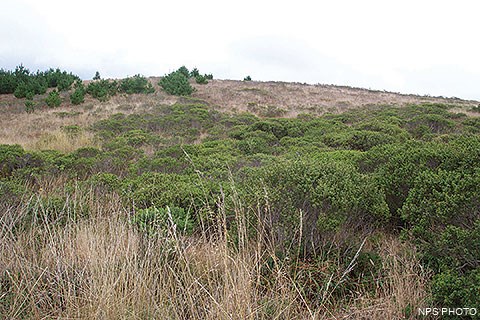|
Coastal scrub is one of the most widespread plant community types with in the Seashore (see Vegetation Map). Large areas of this vegetation type are found along the western slope of Inverness Ridge out to the coastal bluffs and also on Tomales Point and in the vicinity of Drakes Estero. Coastal scrub is found in a band tens to hundreds of meters wide along the coast from Monterey to Oregon. Southward from San Francisco and Marin, this vegetation type transitions to coastal sage scrub, which has its northern extent in Marin County. This vegetation type covers approximately 15,500 acres at the Seashore. 
Coastal scrub is dominated by coyote brush (Baccharis pilularis), a small-leaved evergreen shrub. Other common associates are California blackberry (Rubus ursinus), poison oak (Toxicodendron diversilobum), Coffeeberry (Rhamnus californica), thimbleberry (Rubus parviflorus), yellow bush lupine (Lupinus arboreus), mimulus (Mimulus aurantiacus), salal (Gaultheria shallon) and blue blossom (Ceanothus thrysiflorus). It may also be found in association with as well as non-native and native grasses, sedges (Carex spp.) and rushes (Juncus spp.). Some coastal sage species are also present including California sagebrush (Artemisia californica) and buckwheat (Eriogonum fasciculatum). Coastal scrub is the climax community in some sites, seral to mixed evergreen forest in other locations, and exists in a shifting mosaic with grassland and forest in some situations. In many areas of the Seashore grasslands give way to coastal scrub without disturbance from fire or grazing. Similarly, scrub will succeed to mixed evergreen forest in the absence of fire (eg Palomarin/PRBO area). It has been estimated the absence of fire for a 50 year period will lead to site transition from scrub to mixed evergreen forest. At the northern end of Inverness Ridge, on the slopes from the ridge top westward to the ocean, coastal scrub exists in a mosaic with bishop pine forest and grassland. After the 1995 Vision Fire, large patches of bishop pine established as tree islands in a matrix of scrub in areas that had previously been coastal scrub. Most coastal scrub species do not need fire to reproduce, but respond well to fire. Many have the ability to sprout vigorously after fire. Coyote brush is normally not killed by fire and is able to sprout from the root crown post-fire. However, in more open coyote brush communities, the herbaceous vegetation component may provide enough surface heat to kill individuals by girdling the root crown so that they cannot resprout. Pre-European fire regimes in coastal scrub communities were likely greatly influenced by Native Americans in the absence of natural ignition sources. Fire return intervals would have been longer than in grasslands since with a fire return interval of less than five years, these communities will revert to grasslands. Fire return intervals were probably comparable to the 10 – 20 year intervals found in forests in the area. More information on the Coastal Scrub Plant Community. Text adapted from the Point Reyes National Seashore's Draft Wildland Fire Resource Advisor Guide (2,436 KB PDF).
|
Last updated: February 5, 2024
